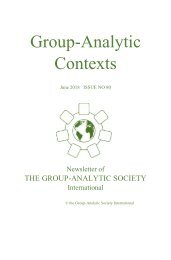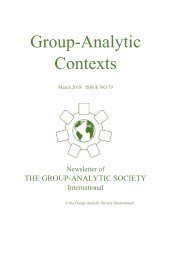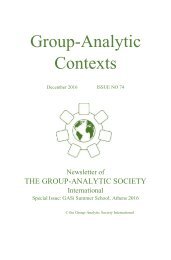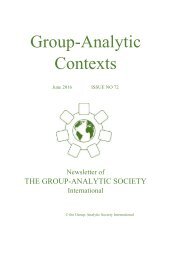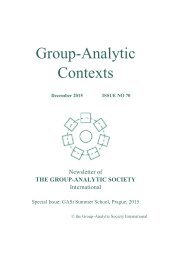Group-Analytic Contexts, Issue 81, September 2018
Newsletter of the Group Analytic Society International
Newsletter of the Group Analytic Society International
You also want an ePaper? Increase the reach of your titles
YUMPU automatically turns print PDFs into web optimized ePapers that Google loves.
Newsletter – Autumn <strong>2018</strong> 9<br />
embraced this philosophy, resisting my natural tendency to use ten<br />
words when one or two would suffice.<br />
I encountered a further complication during my training as<br />
a psychotherapist, when I was told that confusion was not only a<br />
virtue but an absolute necessity if one was to make progress either as<br />
a patient or as a therapist. One of my supervisors at the Maudsley<br />
Hospital, a psychoanalyst by the name of Irving Kreeger, introduced<br />
me to the notion that individuals who began their therapeutic journey<br />
from a position of clarity had to be patiently guided into a mind-set of<br />
uncertainty in which their formerly held assumptions could dissolve<br />
to be reassembled later in a different constellation. In other words,<br />
patients first had to be rendered confused before they could focus on<br />
reality. Clarity, it seemed, was a tempting solution to life’s problems,<br />
but it could also lead people horribly astray.<br />
It slowly dawned on me that confusion could be creative as<br />
well as destructive. Creative confusion allowed the mind to open up<br />
for the entry of new thoughts. Bob Hobson, a Jungian psychoanalyst,<br />
espoused this philosophy of therapy. Supervision with him<br />
seldom advanced beyond reflections on the opening words of the<br />
conversation between patient and therapist but was immensely<br />
informative. Time faded into the background and it became<br />
possible to dwell on the infinite meanings and inflections conveyed by<br />
a single word or gesture.<br />
At the opposite end of the spectrum were the diagnosticians<br />
- people whose contribution lay in the collection and ordering of data<br />
into compartments which then opened the way to an infinite number<br />
of diagnostic possibilities. Prominent among these practitioners was<br />
Sir Aubrey Lewis, a polymath and obsessional character who<br />
intimidated registrars with his ferocious insistence on recording every<br />
jot and tittle of the patient's life history and examination. I disliked the<br />
rigour which this approach called for and much preferred to paint the<br />
canvas with random strokes and see what picture emerged.<br />
In a group, the scope for confusion is limitless. One is<br />
dealing, not just with the muddle of one mind but several minds<br />
thrumming together in various degrees of harmony and cacophony.<br />
The art of making sense of all this proved too much for some<br />
diagnosticians of my acquaintance, and many a good psychiatrist was<br />
lost to the world of group psychotherapy for this reason.<br />
I suppose it all depends on one’s ability to tolerate<br />
uncertainty. According to the model of Sir Aubrey Lewis, which we<br />
can think of as the disease model, the patient’s journey through illness<br />
has a fairly neat trajectory with a beginning, middle and end. Study of



